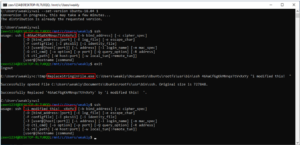

In the Session page you need to specify the server IP and the SSH port (22 is the default):Īnd in the SSH/Tunnels configuration page you specify how the tunnel will be created:
PERMANENT SSH TUNNEL WINDOWS 10
Windows 10 has a native client since the 1809 “October Update”, but I’ll stick with PuTTY as this is a dominant utility for system admins. So, having both the SSH Server and the database instance (PostgreSQL in my case) open and running on Linux, we can try the first connection from Windows using any SSH client terminal. Testing the Connectionīefore trying the connection from FireDAC, it’s a good idea to prove the connection using just command-line tools that are an integral part of the operating systems, so you have an idea if things are working or not. This is for Oracle Linux (this is what I’m running due to another proof of concept I had to do last week) but you’ll find similar tutorials for your preferred Linux flavor. Basically I have a Linux VM running a PostgreSQL database (this is the database the customer would like to connect, but the solution is database agnostic), and over it I’ve installed and started an SSH Server following this tutorial:

PERMANENT SSH TUNNEL HOW TO
The aim of this article isn’t to teach you how to create an SSH Server, but I had to create one to test my solution, so here is what I’m using. We’ll see two ways to establish an SSH tunnel: one using an external tool (PuTTY) and the second one directly coded in your application. What you need to do is create a permanent SSH tunnel and then properly configure your database connection. The key thing to remember when using FireDAC via an SSH secure interface is that FireDAC (or any other database access framework) has nothing to do with it. If you’ve ever used PuTTY to connect to a remote command-line interface, most likely a Linux system, SSH was the protocol you used. Linux, UNIX, macOS, and now Windows are all supported (natively speaking). Start the ssh tunnel using autossh: autossh -f -D 5555 -N -M 0 Shell (ssh) is a standard tool that comes with most “network” operating systems, such as Windows. The ssh session can not prompt for a password. Ssh key authentication must be setup prior to using autossh. To handle network instability, VPN connectivity, and laptop mobility, autossh automatically restarts the ssh tunnel during network changes or failures.

The SwitchyOmega plugin takes care of site specific proxying and autossh securely forwards all SOCKS traffic through the ssh tunnel. To access websites behind an internal network, I proxy web traffic to specific DNS domains over an ssh connection using the SOCKS protocol.


 0 kommentar(er)
0 kommentar(er)
